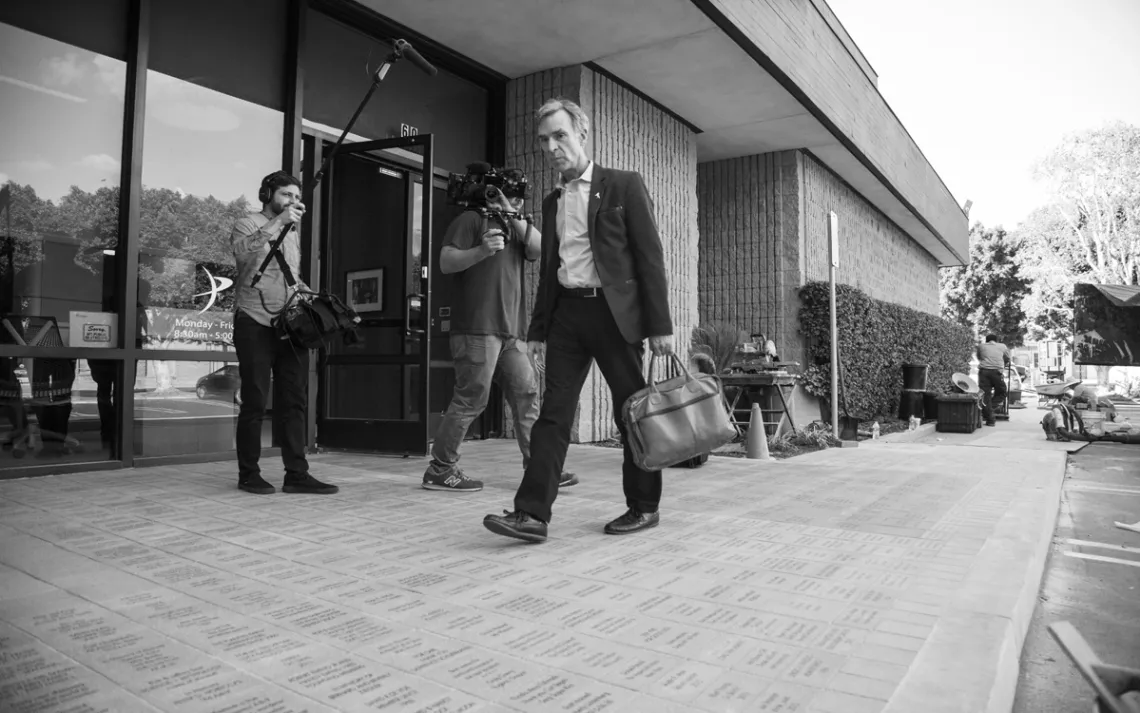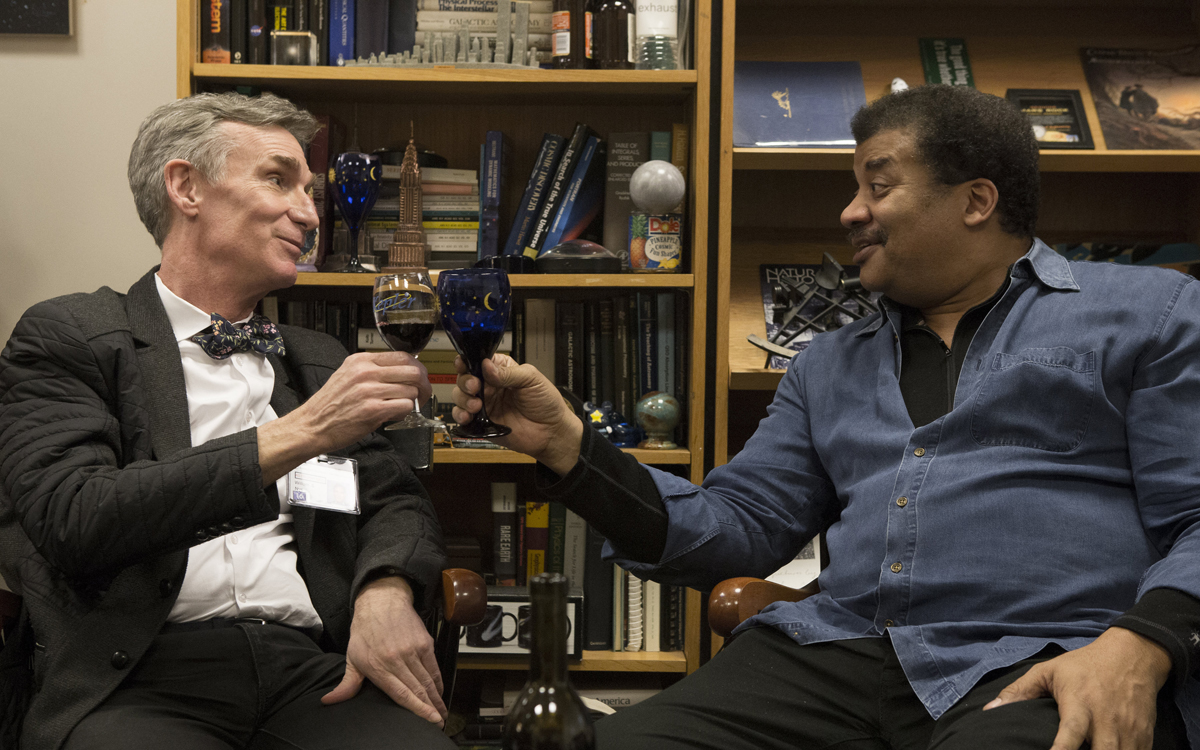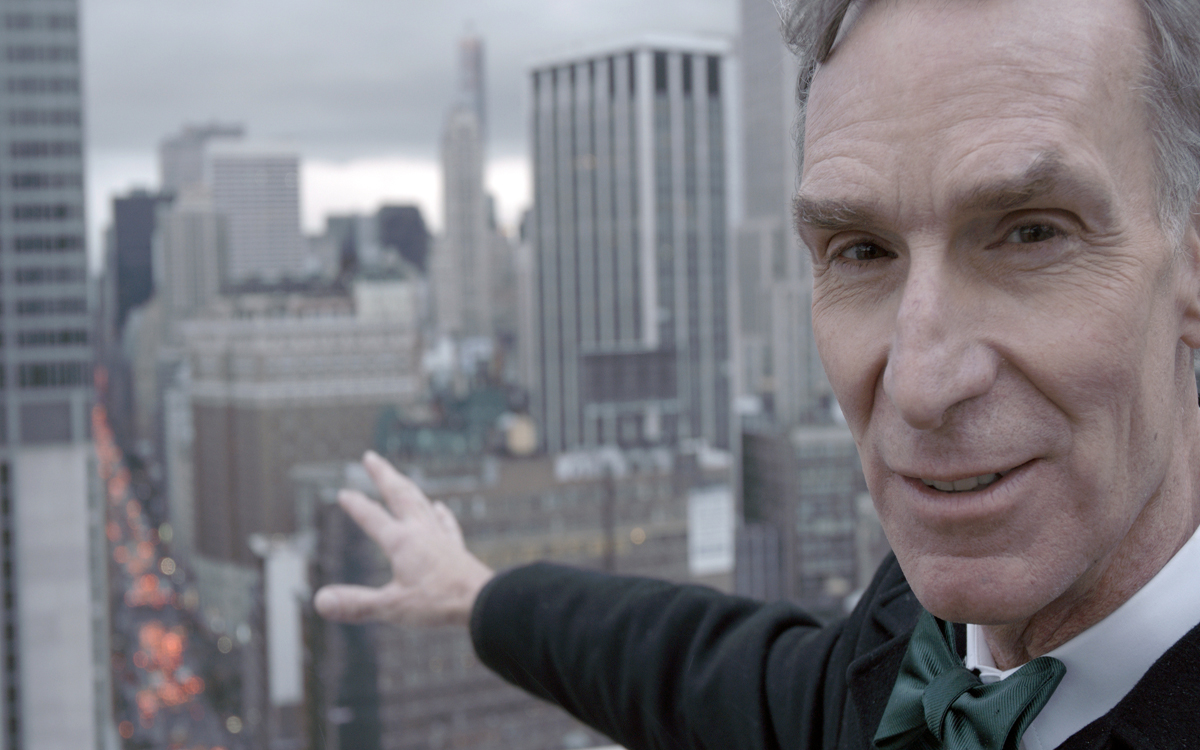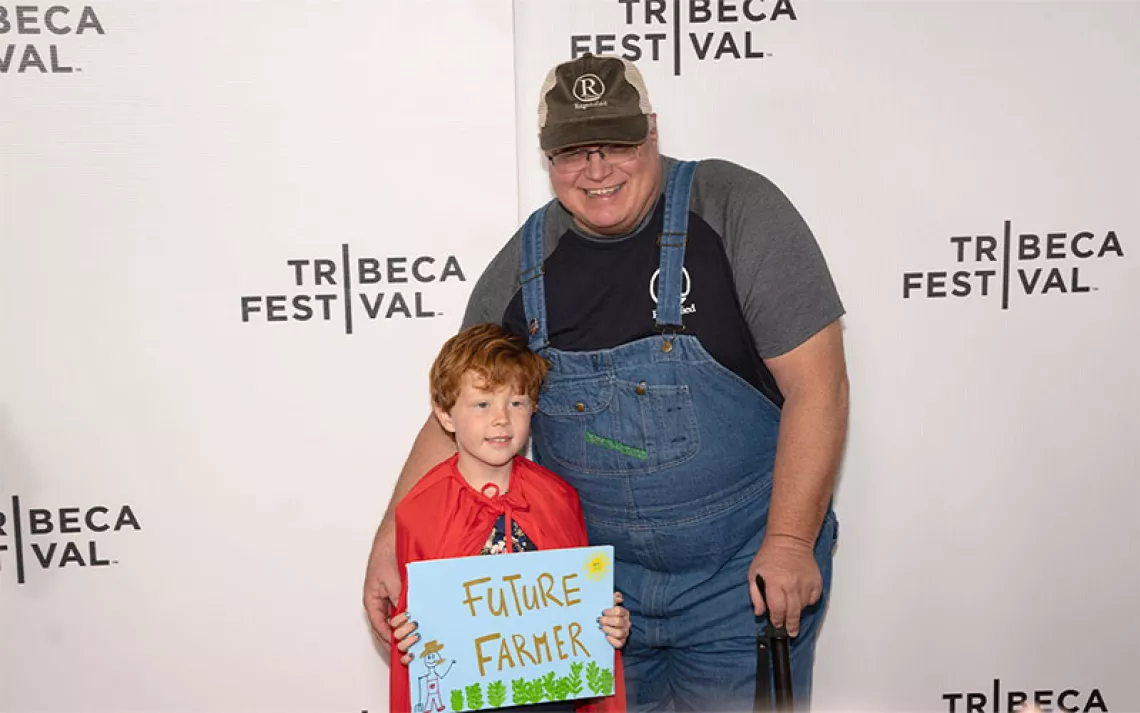New Film Reveals Bill Nye as Lifelong "Science Guy"—and Climate Guy
Inside the longtime Sierra Club member’s quest to end anti-scientific thinking

Photos courtesy of PBS Distribution
What happens when America’s favorite scientist takes off his “Science Guy” lab coat? The star of the hit kids’ show Bill Nye the Science Guy, which fetched 18 Emmy Awards over the course of its 1993–98 run, never did stop advocating for science, research, and discovery. But these days, William Sanford “Bill” Nye wants to educate an older generation.
 The former Boeing engineer and stand-up comic presently serves as CEO of The Planetary Society, a nonprofit advocacy group founded by his mentor, Carl Sagan. In this role, Nye frequently collaborates with astrophysicist Neil deGrasse Tyson and spearheads the LightSail project: a Sagan branchild that involves launching small, solar-powered spacecrafts. He also travels the world trying to convince the masses of the importance of science and space exploration, has authored several books, co-chaired the 2017 Science March, and created last spring’s new Netflix series Bill Nye Saves the World. In his free time, Nye sometimes takes to the airwaves to fight the good fight against high-profile climate-change deniers and creationists.
The former Boeing engineer and stand-up comic presently serves as CEO of The Planetary Society, a nonprofit advocacy group founded by his mentor, Carl Sagan. In this role, Nye frequently collaborates with astrophysicist Neil deGrasse Tyson and spearheads the LightSail project: a Sagan branchild that involves launching small, solar-powered spacecrafts. He also travels the world trying to convince the masses of the importance of science and space exploration, has authored several books, co-chaired the 2017 Science March, and created last spring’s new Netflix series Bill Nye Saves the World. In his free time, Nye sometimes takes to the airwaves to fight the good fight against high-profile climate-change deniers and creationists.
A new cinematic portrait dives deep into the perennially bowtied celebrity's quest for science literacy, space exploration, and climate-change mitigation. Through visits to the protagonist’s childhood home and candid interviews about personal topics—including but not limited to the effects of fame and Nye’s choice to remain single and childless—Bill Nye: Science Guy reveals the man behind the zany TV persona.
The film, an NYT Critic’s Pick that premiered at this year’s South by Southwest Film Festival, explores America’s fast-growing anti-science movement and Nye’s quest to overcome it. Bill Nye: Science Guy also delves into Nye’s formative relationship with Sagan, his professor at Cornell (where Nye earned a mechanical engineering degree in 1977), and his quest to fulfill his hero’s never-realized dreams of launching a LightSail into outer space. The movie documents this triumph, and captures the protagonist's wittiness and vulnerability. Plus, there's feel-good footage of Nye at a conference surrounded by adoring science teachers and former child fans (many of whom credit Nye for their decisions to pursue careers in science).
Its most topical and urgent moments, however, involve Nye engaging firsthand with two larger-than-life climate-change deniers: anti-evolution bigwig Ken Ham—founder of Kentucky’s Creation Museum and Ark Encounter—and bodybuilding meteorologist Joe Bastardi, the former chief forecaster at AccuWeather and frequent Fox News guest known for his insistence that extreme weather is but a meteorological variation. Nye descends on Ham’s tourist attractions, where exhibits show Flintstone-like humans cohabitating with dinosaurs, proclaiming, “Here is anti-science.” During a visit to Bastardi’s home, both the Science Guy and the contrarian weatherman reveal themselves as charismatic-yet-resolute opponents. The film also invokes the intergenerational complications of climate-change denialism through Bastardi’s college-age son, Garrett—during Nye’s visit, the younger Bastardi begs his father to “please not” get too mad at his childhood hero. “[Bill Nye is] like the Easter Bunny and Santa rolled up in one.”
After taking in the sparkling film, Sierra called up Nye. The longtime Sierra Club member graciously delved deeper into some of its tenets—namely, how to talk to climate-change deniers, internet literacy in the age of Trump, and using science as a tool to uncover the antidotes to alternative facts (those would be facts).
Sierra: Studies show that watching Bill Nye the Science Guy made kids in the 90s like science better. Can you talk about the ways in which your messaging changes when you’re talking to adults?
Bill Nye: It takes a lot more repetition—especially when you’re talking about the climate—because adults are much more close-minded; they’ve had their opinions for decades. I really wonder about people like Garrett Bastardi, son of Joe Bastardi, because Garrett’s in college—at the age when you decide what you’re going to do with your life. He’s at Penn State, his father’s alma mater, and so is renowned atmospheric scientist Dr. Michael Mann, creator of the powerful hockey-stick graph [which arguably launched mainstream discussion of climate change in U.S. politics]. It’s a university with a long tradition of meteorology achievement. So someone like Garrett could become a climate scientist like Mann, or a meteorologist like his father, and I’d really like to see which direction he takes. We’ve been in touch with him to invite him to screenings of the film—I offered to pay his way—but he hasn’t taken us up on it, and we’re not sure why.
What do you see as a bigger challenge: climate-change-denying scientists like Joe Bastardi or anti-science creationists like Ken Ham?
There’s not much difference between climate-change deniers, but as I told Ken [Ham], the proselytizing is the worst thing he can do. I don’t have an issue with anyone’s religion, but there’s no connection, logically, between denying overwhelming evidence about the existence of Earth—telling people that it’s 6,000 years old is weird, considering we have 40,000-year-old trees and 10,000-year-old pyramids, yet people like Ken claim the earth was under a flood 4,000 years ago that I guess no one noticed—and saying that there’s no such thing as human-caused climate change. So, that’s one aspect of climate-change denial that’s really, really bad.
 Getting back to kids for a moment, can you talk about the kinds of changes you’d like to see in American science curricula?
Getting back to kids for a moment, can you talk about the kinds of changes you’d like to see in American science curricula?
Science every day in every grade—from preschool all the way through high school! Kids younger than fourth or fifth grade respond to science in fabulous ways. When did you realize you wanted to tell stories? We all develop our passions very early in life. And kids love science. Eat your hearts out, teachers. Blow stuff up!
But the most important thing to teach in classrooms is the process of science—how we know what we know and what evidence we have to establish the earth’s right, natural laws. What we need right now isn’t to memorize scientific facts or the periodic table—we need people to be able to think critically. The skill we need to be teaching people now isn’t how to find information, but rather how to sort the reasonable from the unreasonable—how to think critically about the information you find, for example, on the internet. Because the fossil fuel industry has worked so hard to introduce doubt. The guy I marvel at all the time is [right-wing political consultant] Frank Luntz, who does research about what voters are thinking and who consulted Republicans on how to tell their constituents to be sure to doubt everything they hear and see from scientists. People like him have been so successful that the electorate is now fully polarized, and people like Joe Bastardi are regularly going on Fox News and saying contrarian stuff before huge audiences, based around the deeply held belief that all regulation is bad.
What’s your favorite way to teach audiences to embrace the process of science?
To remind everyone I have no dog in this hunt—or cephalopod in this search—I like to encourage people to check out the “Tree Octopus” online. Spoiler alert: There’s no such thing as a tree octopus; it’s an internet hoax that can teach you a valuable lesson about online literacy. And one of the most popular Science Guy titles is “Pseudo Science,” a demonstration about how people realized the earth is round. I’m not saying it’s my favorite of all time; I’m just saying it’s pretty good.
In the film, you advocate for more space exploration and tout the LightSail as a means to broaden our understanding of climate science. Can you elaborate on that?
So, the LightSail is an old, romantic idea—sailing on light pressure. It’s the coolest thing ever. And we’re hoping that someday, large solar sails are built and used, because they’re cheap to build and never run out of fuel—they don’t need fuel! There are two missions they’re ideally suited for. One is going above the poles and monitoring the earth’s climate all the way down to the equator, like a fish-eye lens. LightSails never run out of fuel like satellites, which eventually can’t work anymore and have to be de-orbited. Two, we don’t want the earth to get hit with an asteroid; that’s really undesirable. It’s control-alt-delete for civilization. But looking for an asteroid in space is like looking for a charcoal briquette in the dark. However, just a little bit of sunlight helps. But if you get a traditional spacecraft close enough to the sun, it gets sucked in and disappears. But with a solar sail, you can catch the sunlight and convert solar rays’ pressure into forward momentum, which will keep it in orbit. It’s ideal for asteroid searches. I’m optimistic about LightSails, because everybody loves space; it brings out the best in us. Congresspeople from either side of the aisle like space. Anywhere in the world, people respect what NASA does—people who hate the U.S. still accept that NASA’s pretty kickass.
In the film you touched on the importance of diversity in STEM fields. Could you elaborate on why you think increased representation of women and minorities benefits the scientific field?
Science is for everybody; it’s true no matter your ancestry or your sex, so let’s get as many people to participate as possible. So, it should be pursued by everyone. Indeed, cultures around the world that are successful—from the ancient Chinese to the modern oil-field drillers—tend to be the ones that have embraced science. And diversity of people promotes diversity of thought, which is critical for the scientific process and creative problem solving. Half the world’s population are women, so in an ideal world, half the engineers and scientists would be women.
At a time when federal climate policy seems woefully insufficient to most scientists and environmentalists, what can an individual do to help mitigate and reverse climate change?
I tell everybody, vote. Voting is the most effective thing you can do. The other thing I tell people is, talk about it. If we were talking about climate change the way we talk about what happened in Charlottesville or [Sutherland Springs] Texas, we’d be getting 'er done. It makes me think of my parents, both of whom served in World War II. My dad was captured by the Japanese and spent four years as a POW, and my mom was recruited by the navy to work on neutral shipping code. They’re both veterans, but still, at that time, everyone was talking about the war. That’s what consumed and united the country—winning World War II. The posters were all about it, and so were the cars, the ads, the food, the music—everything in America was channeled toward winning the war. And it worked! It resolved a global conflict in less than five years, so there we go. That’s what we should be doing with climate change. Get 'er done!
 The Magazine of The Sierra Club
The Magazine of The Sierra Club



